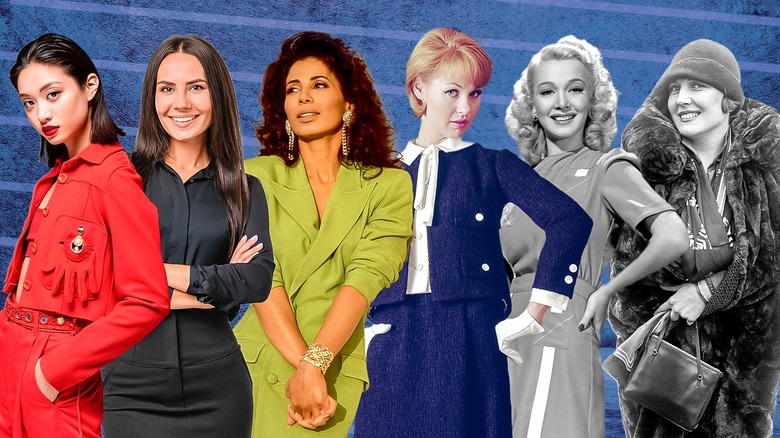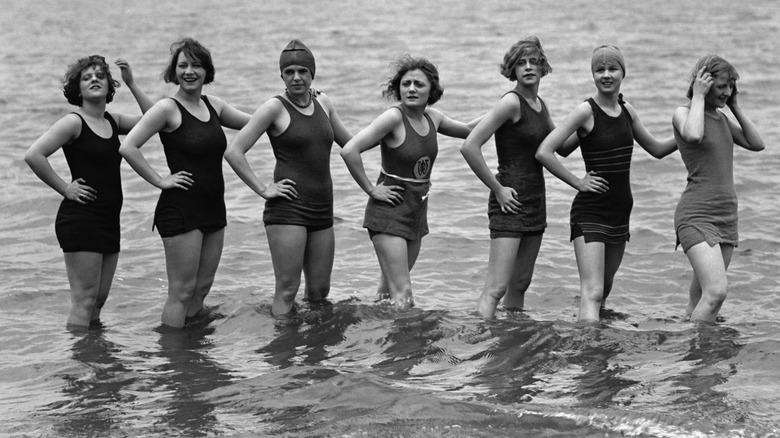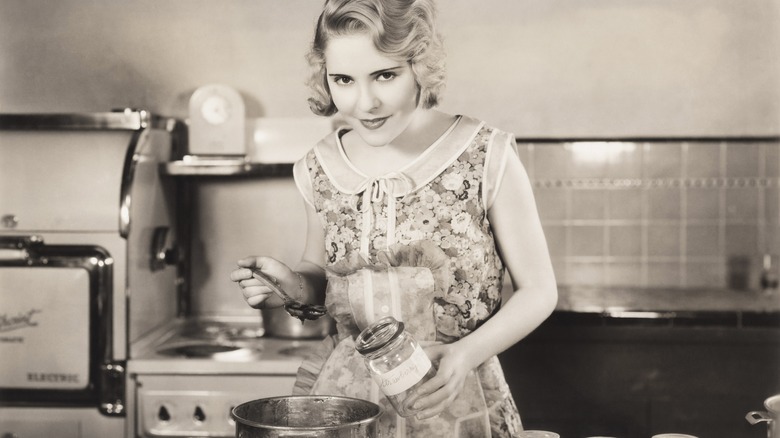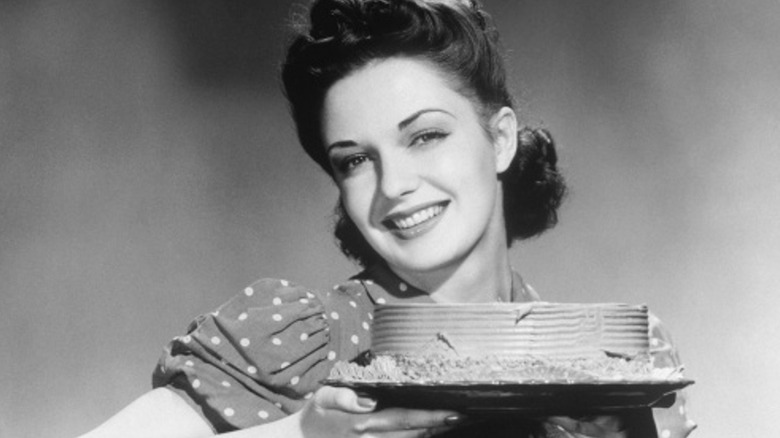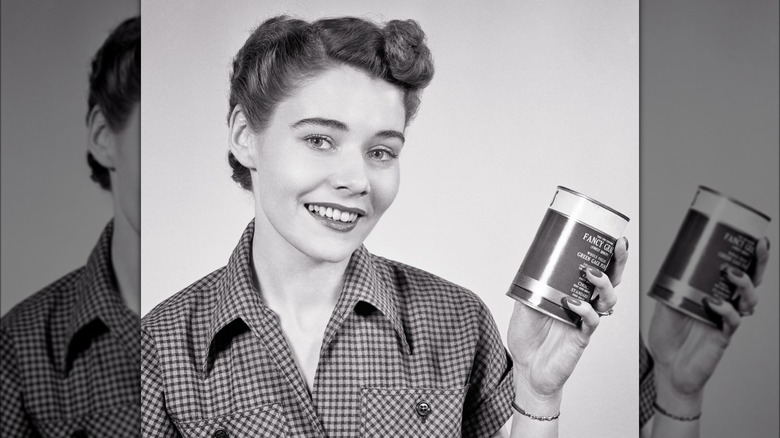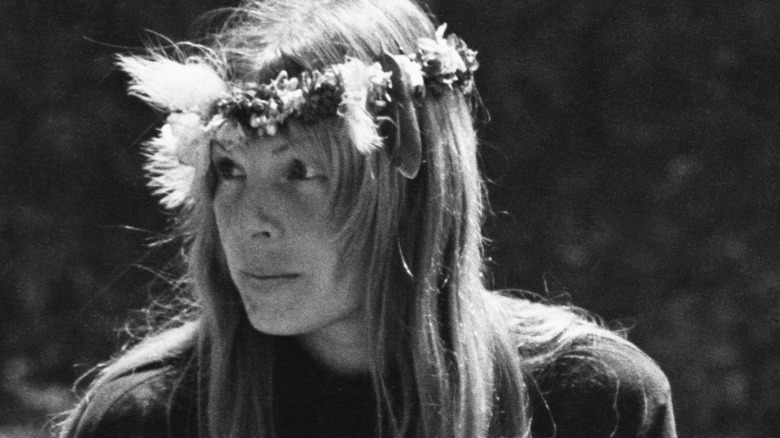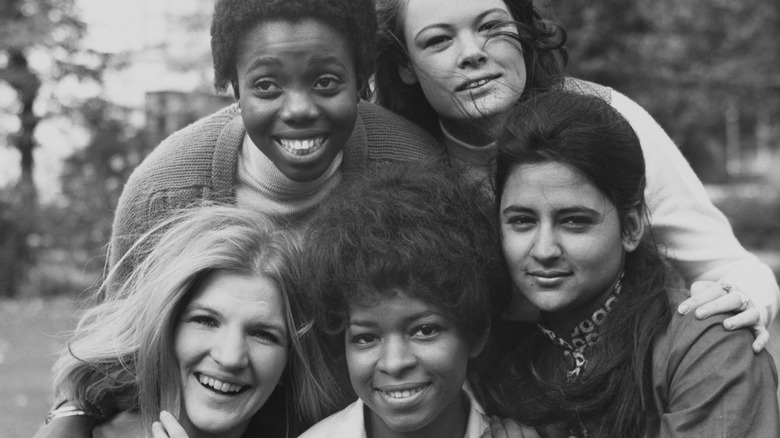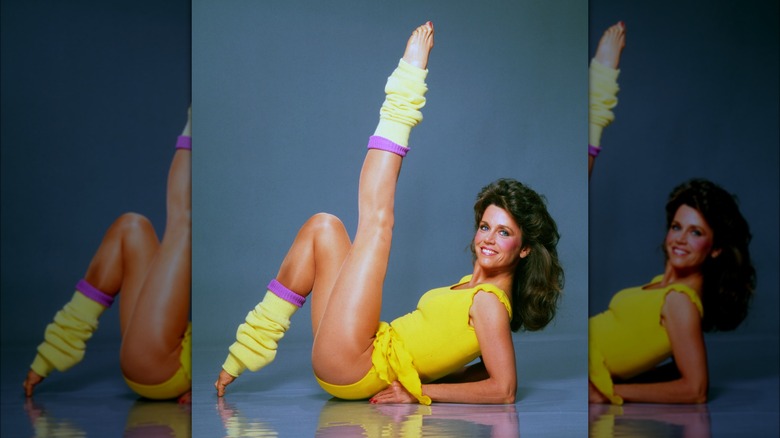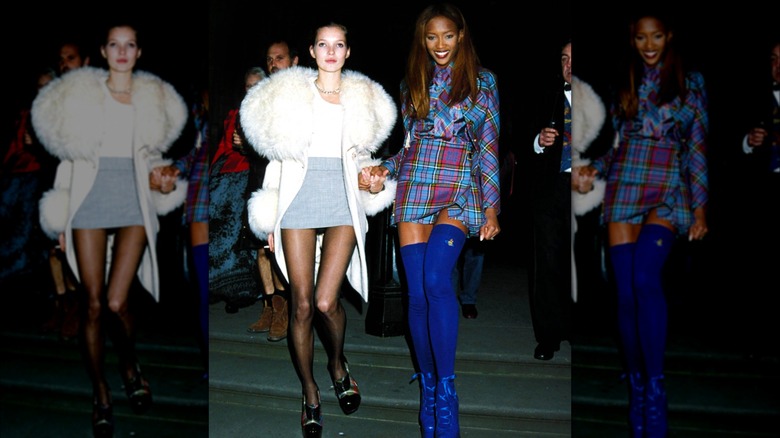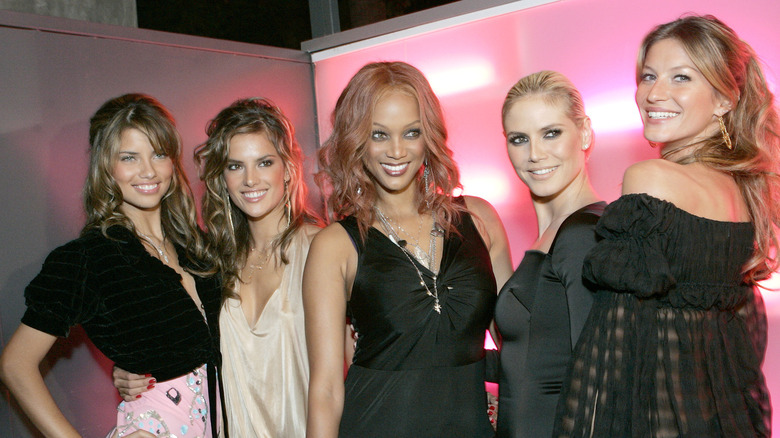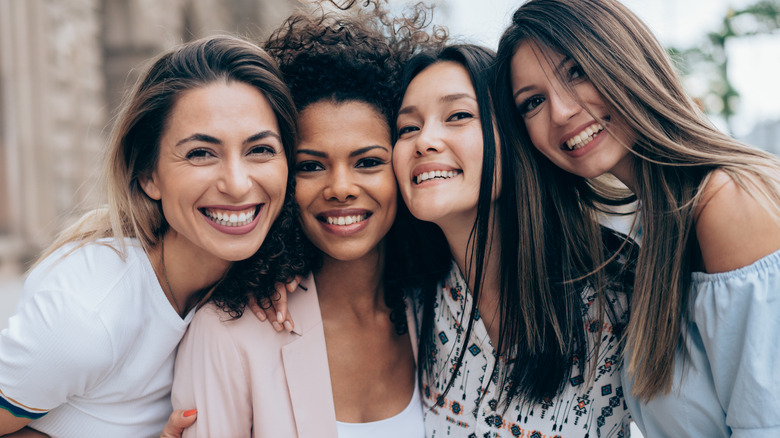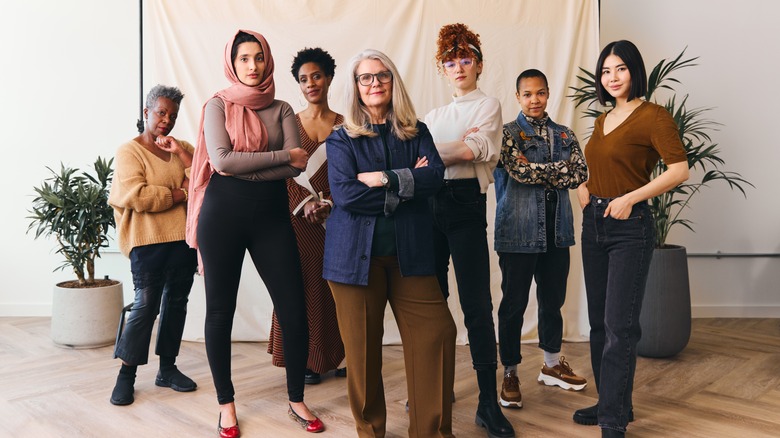The Evolution Of What Partners Look For In A Woman
The evolution of the ideal woman and what made her the perfect partner has continually shifted and evolved throughout the decades. In the last century alone, the ideal woman's physical appearance, fashion sense, and personality characteristics have changed in dramatic ways. "Over the course of the last 50 plus years, the American ideal has shifted from curvy to androgynous to muscular and everything in between," Sierra Filucci, executive editor of parenting content and distribution at Common Sense Media, shared in an interview with CNN. "As those ideals change, they are reflected and reinforced in the culture through media — whether it's fine art or advertising billboards or music videos."
That is to say what the ideal woman embodies today is not what she always has, and that societal expectations and the collective culture have long been major proponents of what this woman should be. Consequently, they have also determined what (traditionally heterosexual) men have found attractive and looked for in their partners. Gender roles and female stereotypes have also perpetuated certain ideals sought after by men in want of a partner. Thankfully for the modern woman, much of what made a woman an ideal partner throughout history is no longer the only path toward happiness or fulfillment. The evolution of what partner's look for in a woman has been an interesting ride, to say the least.
1920-1929: The rebellious young woman
The preferred woman and partner in the '20s was a far cry from the ideal woman of previous decades. Society as a whole began to embrace a faster paced, prosperous lifestyle, and those with means enjoyed the perks of an urbanistic, consumerist society. The culture collectively shifted its focus toward all things vibrant, youthful, and fun. Consequently, women's lifestyles, attitudes, and fashion choices shifted to the provocative, unconventional, and rebellious. Prior to getting hitched, young women spent their free time drinking, smoking, and dancing at speakeasies alongside men. More visible in society than ever before, they bobbed their hair and painted their faces with generous applications of makeup, scorning what was traditionally thought "immoral" or "loose." The Roaring Twenties celebrated slim, boyish figures and short, narrow garments.
Although motherhood and managing a home for her husband were still heavily expected of the ideal, marriageable young woman, women had a semblance of freedom and control over their own lives. These newfound freedoms extended into the types of partnerships that many women sought out. "There's more of a sense, not of equality, but more of companionship between men and women in marriage," professor and author Lynn Dumenil explains to History. For the first time in modern American history, men and women dated one another without chaperones or the promise of a long courtship ending in marriage. They were brazen and outspoken, and enjoyed the single life to the fullest. Men appreciated these characteristics in women alongside their courage and rebellious strength.
1930-1939: Humble and resourceful
The decadence and glittering excess that arose in the Jazz Age came to a screeching halt with the stock market crash of 1929 and the subsequent Great Depression. Women no longer had access to many of the rebellious luxuries they once enjoyed. Once again, the average woman became responsible for running a household and raising a family. While this was seen as ideal and noble work for married women, many young, single women worked outside the home in areas relatively untouched by the Great Depression, such as sewing, clerical work, and teaching. Times were hard, which meant spirited, resourceful, and humble women who didn't complain were valued by their partners and society.
Fashion and beauty ideals changed drastically in the 1930s as well. The straight lines and boyish figure popular in the 1920s was replaced with a softer, more feminine body type reflected by more a romantic style of clothing. In a 1938 issue of Life, the ideal body type for a woman was described as having "a round, high bosom, a slim but not wasp-like waist, and gentle rounded hips." The ideal 1930s woman was beautiful and aware of her beauty, but she was not overtly showy about it. Hollywood beauty standards of the time dictated that a perfectly symmetrical, oval-shaped face with rosy cheeks was the "perfect face," although these commercialized ideals were almost exclusively based on and catered to conservative, white women.
Practical but effortlessly feminine
World War II drastically altered the way women dressed and behaved outside the home in the absence of their husbands, though not at the expense of expected grace and femininity. The dating scene prior to the war was significantly more chaste and formal than the previous decade, with men and women looking for long-term, serious partners they could fall in love with.
As more men were shipped overseas to fight, both single and married women took their places in factories, lumberyards, and construction sites to support the war effort and feed their families. Despite the physically demanding work they were successfully accomplishing, women were expected to maintain a feminine image and adhere to the established gender roles. Even Rosie the Riveter, with her physical strength and tough-as-nails attitude, was portrayed wearing carefully applied makeup and styled hair beneath her practical headscarf.
Practicality and frugality also played a big role in the way the ideal woman presented herself during this time period. Wartime rationing and a struggling economy limited the availability of fabric and certain cosmetics, which forced women to adapt their sense of style. Outfits were simple, comfortable, and conservative. As the average woman's wardrobe was relatively small, women's clothes were also versatile to accommodate a range of looks. Wrap and utility dresses, boxy padded shoulders, slim waists, and V-necked collars were main features of a stylish woman's daily look. Figure preferences began to shift back toward an hourglass shape, while longer curled hairstyles came back into fashion.
1950-1959: The happy homemaker
No matter what historical and societal shifts occurred throughout the early 20th century, the ideal woman always had some ties to being a wife, mother, and manager of her family's home. However, no decade was more singularly focused on women fulfilling the perfect homemaker role than the 1950s. Everyone was enjoying the peaceful glow of a postwar country and a booming economy, and the American government focused their attention on building and strengthening the perfect nuclear family. Traditional gender roles returned in full force as a result, with both men and women expected to play their parts.
Many women in the 1950s went to college in pursuit of a degree, although most had no intention of using their degree to pursue a career. Their goal was to meet a man with a good job and get married young. In return, men expected their partners to be domestic goddesses, planning and cooking the meals, cleaning the house, and fulfilling all of the chores running a home entailed while they went off to work. The also expected their wives to raise the children. Traits like organization, efficiency, and a dedication to their duties were considered admirable. Of course, women also needed to maintain their figure, be ladylike, and look attractive at all times. A shapely figure with a large bust, narrow waist, and rounded shoulders was in style, all of which were emphasized by relatively conservative dresses with natural waistlines and full skirts.
1960-1969: The newly liberated woman
The 1960s was a time of great political and social upheaval, and as such was a mixed bag for what made an ideal American woman attractive to a potential partner. Initially, being a selfless, doting, effortlessly beautiful wife and stay-at-home mom was still a major expectation for a woman's life. But as the decade wore on, the increased availability of contraception, the tumultuous civil rights, LGBTQ+ rights, and feminist movements, plus the increased demand for women's equality began to liberate women from their traditional societal roles. Some partners began to look for girlfriends and wives that spoke out against injustices and fought for their own equality. Others sought partners that adhered to traditional norms, in which men were the sole breadwinners and women were wives, mothers, and homemakers that kept the family life running smoothly.
At the beginning of the decade, a beautiful, fashionable woman had a thin, narrow frame and a doll-like face. Women were encouraged to slim down through the use of amphetamines and dieting to achieve the sought-after petite figure, as exemplified by famous women like Twiggy, Jackie Kennedy, and Audrey Hepburn. Toward the end of the decade, the counterculture movement introduced a more natural aesthetic, with women adopting prairie-style skirts, bohemian dresses, and long natural hair. The idea of "healthy" was rapidly becoming synonymous with beautiful, with more women adopting the "no-makeup" makeup trend that would persist into the following decade.
1970-1979: Feminists and social justice warriors
Marriage in the 1970s was less of a practical business proposition and increasingly a partnership based on foundations of romance and love. There was also more focus on marriage being an equal contract between two people, although men were still considered the dominant figure in any relationship, and traditional women's roles prevailed in many households. The 1970s saw interracial relationships become more accepted in mainstream society. Same sex couples had more opportunities to date and marry as well. Sexual freedom was the cornerstone of the dating world thanks to newly legalized access to the birth control pill, with formal dates shifting to casual "hang-outs." Many committed couples of this decade lived together before getting married, although divorce rates throughout the decade rose.
In the early part of the '70s, women were often viewed as passive, indecisive, and unworldly in comparison with their male counterparts, despite their persistent entry into the workforce and demand for equality. Women of diverse backgrounds were eager to prove this way of thinking wrong, fighting fervently for feminist liberation and working tirelessly to end the discrimination and oppression they'd endured in a historically racist, sexist, patriarchal society. They voiced their discontent and showcased their intelligence and independence proudly. Men who allied with this second wave of feminism no longer disproved of their partners working outside the home and worked alongside them to end violence and discrimination.
1980-1989: The fit, preppy, all-American girl
The stereotypical woman in the 1980s was confident, fun, and wealthy. An "all-American" girl, she was pretty and kind, wholesome and smart. She wore bright colors and bold patterns, teased and sprayed her hair into fluffy, voluminous curls, and accentuated her eyes with electric blue eyeshadow. She took fashion advice from Cyndi Lauper and Madonna but let Jane Fonda teach her how to stay slim.
In decades past, strength, competition, and fitness were considered masculine traits and were therefore deemed unattractive in a woman. But thanks to a fitness and nutrition craze that swept the nation, women who were toned and active became desirable. In a 1987 Washington Post article, beauty editor of Vogue Andrea Robinson noted the important role a healthy, glowing look played in a woman's perceived beauty at the time. "What all beautiful women today have in common is an obvious look of health," she explained. "Even a model's skin tone implies she leads a healthy life. This is the look today's women try to achieve."
Both men and women of this decade looked for partners who could be sources of emotional support and who were conventionally attractive and "well-built." Couples also sought out relationships that offered companionship and support. They wanted a partner they could rely on to help them navigate the tough times, and many needed a partner who could contribute financially to the household.
1990-1999: Thin is in
The '90s was a time of high anxiety about the state of the world. In a 1990 Los Angeles Times article, author Susan Baer explains that men and women both were seeking nurturing, stable relationships based on trust and commitment to help them navigate the uncertainty they faced in a rapidly warming, economically fraught world. People wanted a partner they could count on and who shared the same values. Men's attitudes about women having professional ambitions and high-paying jobs began to shift and were now seen as valuable and necessary. Women who were self-sufficient and independent also became attractive, with personal fulfillment and happiness becoming important signs of a healthy marriage.
Beauty standards for the ideal woman continued to emphasize the importance of thinness, with models and celebrities like Naomi Campbell, Kate Moss, Halle Berry, and Alicia Silverstone embodying what it was to be an attractive woman for all genders. "The term that gets so much associated with that decade is the '90s is the moment of the waif," Emma McClendon tells CNN. "We begin to see a stark divide in the way bodies are presented across the media, with extreme thinness celebrated in fashion imagery while larger bodies are highlighted as 'unhealthy' and bad in reporting on obesity."
2000-2009: Sexy, strong-willed, and successful
Women of the early 2000s were independent, ambitious, and sexually liberated. They had careers, power, and control over their own finances, while personal ambition and determination were admirable character traits to possess. A study published in the December 2000 Journal of Psychology & Human Sexuality saw a shift in attention to preferred personality traits in a potential long-term partner versus sole external qualities like physical attractiveness. Although how athletic or attractive a potential partner might be played a key role in their viability as a short-term fling, partners were increasingly interested in how intelligent, honest, or warm a woman was if they were to be considered for long-term partnerships. Companionship remained important, as did a sense of shared intimacy and independence.
Despite this positive shift in autonomy and healthy, committed relationships, beauty standards in the early 2000s were less than ideal. For young women especially, "It was blatant, horrifying misogyny," Ben Widdicombe tells The Guardian. The internet made fixating on celebrities' lives, beauty regimens, and diets more accessible than ever, and the pop culture media machine fed mercilessly on the insecurities of women because of it. Fat phobia was rampant, and women who did not look like "it-girls" of the day like Jennifer Aniston and Angelina Jolie, or models like Tyra Banks dove headfirst into the dangers of diet culture.
2010-2019: Educated, intelligent, and driven
While the introduction of online dating apps like Tinder and Bumble dramatically altered the dating landscape, some things stayed the same when it came to romance in the mid-2000s. Falling in love and mutual attraction remained the most important factor for people interested in pursuing a long-term relationship. Partners also sought out women that valued lifelong commitment, companionship, family life, and financial stability, and considered those things before getting hitched. Although couples were getting married later in life, and marriage was no longer required to be considered a socially acceptable member of society, the majority of men and women still viewed marriage as a life goal they wanted to achieve.
What made a woman an ideal partner continued to shift during this decade as well. Most partners believed an educated woman with a college degree and a stable job with a good income was valuable, as it indicated intelligence, accomplishment, and economic security. Personal drive and energy were considered to be attractive qualities in a woman, as was a pleasing disposition, emotional stability, and dependability. A marriage built on a foundation of friendship and passion was also ideal.
2020-Present: The ideal modern woman
Dating and marriage today are nothing like they once were, but neither are women. Despite the continued attack on women's rights and bodily autonomy modern women suffer, women today are more self-sufficient and independent than ever before. They have the education, leadership skills, and confidence needed to succeed in a rapidly changing, unstable world. "The modern woman has the balance of being able to show a soft and supportive side, while at the same time, demonstrating strength — she is resilient, knows what she wants, and speaks her mind," a spokeswoman for OnePoll tells The Mirror.
Mutual physical attraction is still considered important for partners seeking a relationship, although a woman's behaviors, attitudes, and values are seen as much more valuable. Partners desire women who are funny, decisive, resilient, kind, and generous. They also want a girlfriend or wife who is authentic and true to herself, and someone who isn't afraid to take the reins and plan a date night, initiate intimacy, or give out compliments.
The scale of physical attractiveness in an ideal woman is also more diverse than ever before. Thanks in part to social media platforms and the democratization of the internet, beauty standards have become more inclusive, making beauty recognizable regardless of ability, race, religion, body size, or shape. While this positive shift in attitude toward women's bodies doesn't eliminate certain beauty standards made popular by celebrities like the Kardashians, it does offer a glimmer of hope for future generations.
